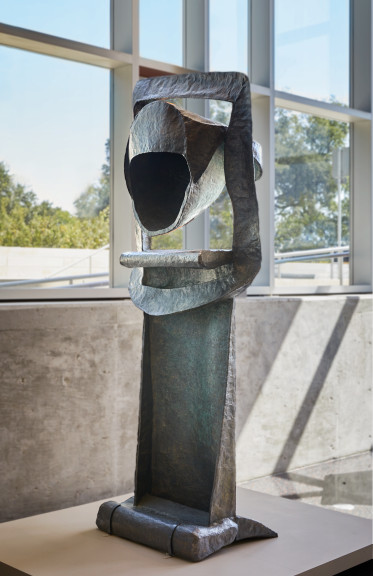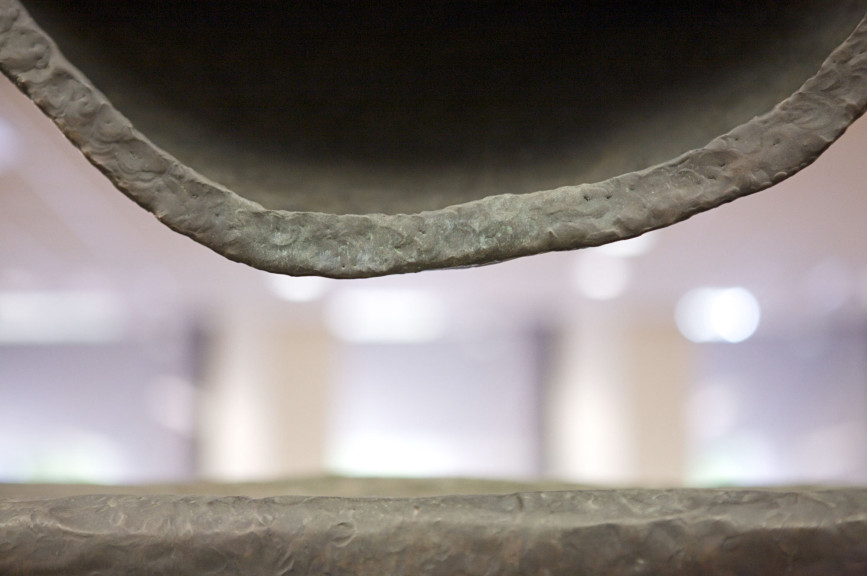Guardian
Seymour Lipton
96 3/4 × 39 3/4 × 26 1/4 inches
Photography not permitted
Lent by The Metropolitan Museum of Art
Gift of the artist, 1986
1986.276.4
30.27544, -97.73303
Seymour Lipton, a self-taught artist, found inspiration in nature, machinery, and the human figure. Engaging with the sociological concerns of his time, he wanted to express the emotional, psychological, and spiritual tensions of balancing conflict: “Sculpture is used by me to express the life of man as a struggling interaction between himself and his environment.” Lipton developed a style characterized by the tension between curved and straight elements, internal hollows and external shells, and industrial materials and organic forms. He said, “I find ‘inner spaces’ of man in things outside of himself.”
Although Guardian presents a totemic figure similar to Pioneer, it conveys a more ominous tone. The “body” consists of a solid rectangle below an opening with a hollowed spherical form that suggests a head with a gaping maw, as if roaring an urgent warning. The more intimidating the appearance, the more effective Lipton’s pieces are at conveying a sense of protection for the weak against harm, the good against evil. Of his sculptures, the artist said, “Man is still an animal. This was shown to us in the past, but the war showed it up more definitely, more clearly. I used all the means at my disposal . . . to find images of horror. Subsequently, however, I came to feel that Hell below wasn’t the whole story, that man had hope.”
Throughout his career, Lipton created a series of monumental, heroic sculptures that express fundamental ideas about human existence—that life is precious but fragile, and that strength is necessary in order to protect it. Despite his dedication to abstraction, Lipton understood his work to be involved in a timeless and universal tradition: “The human figure has always and everywhere been almost synonymous with sculpture. Man has been the exclusive subject for sculptors in every society. He has shaped his gods in his own image.”
ACTIVITY GUIDES
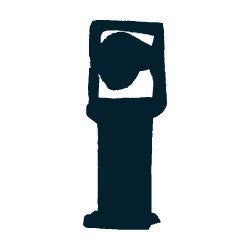
Guardian
Seymour Lipton
Subject: Abstract Expressionism
Activity: Using geometric shapes to collage a figure
Materials: Colored paper, scissors, and tape or glue
Vocabulary: Abstract, representative, geometric, Abstract Expressionism
Seymour Lipton was a dentist before he became an artist. He started off carving his sculptures out of wood, and later he used sheets of metal. Lipton heated sheets of metal so they could be bent and attached to one another. He used geometric shapes, like squares and circles, to make sculptures that represent people and feelings. When artists do this they are working in a style of art called Abstract Expressionism.
What shapes do you see in the sculptures?
Are there any shapes or colors that remind you of certain feelings or objects?
What do you think these sculptures represent?
If they had feelings or emotions, what do you think they would be about?
Using colored paper, help your child cut geometric shapes of different sizes and colors. Experiment by rearranging the shapes to make designs that look like people, familiar places, or represent a feeling.
Shape - A basic element like a square, circle, or triangle that makes up a work of art
Layer - Arranging shapes so that they overlap and create new shapes
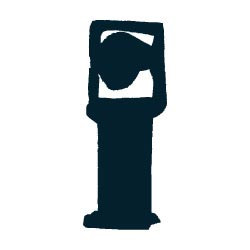
Guardian
Seymour Lipton
Subject: Anthopomorphic forms
Activity: Creat a sculpture using anthropomorphic forms
Materials: Aluminum foil, double-stick tape, scissors
Vocabulary: Anthropomorphic, biomorphic, abstraction, geometric abstraction, Monel metal, nickel-silver
Seymour Lipton began his professional life as a dentist and then became a sculptor. At first he was interested in carving wooden sculptures, but later he worked with metal. He sculpted using thin sheets of Monel metal that had a gleaming silvery appearance. He heated these sheets and shaped them into abstract forms. He also used nickel-silver, which is a hard silver-white metal that looks like a nickel.
The abstract forms Lipton created were sometimes anthropomorphic in that they resembled human forms. Seymour Lipton’s artistic style is biomorphic and geometric abstraction.
What materials did the artist use?
Which sculptures do you think look friendly? Threatening? Explain why.
What parts of the sculptures are anthropomorphic? Explain.
What do you think makes these sculptures both biomorphic and geometric?
This artist folded and cut thin sheets of metal to create these sculptures. Make your own sculpture by adhering several pieces of aluminum foil together using double-stick tape. The sheets should be bendable and have a nice weight. Then cut and fold the foil to make your own anthropomorphic sculpture.
Anthropomorphic - Having human characteristics (like legs, arms, or expressions) Biomorphic abstraction - Organic shapes taken from nature that are not realistic Geometric abstraction - Lines and shapes that are not realistic
Monel metal - A thin silver metal
Nickel-silver - A hard silver metal used to make nickels
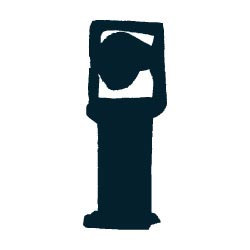
Guardian
Seymour Lipton
Subject: Abstract expression of feelings
Activity: Create a painting, drawing, or sculpture of a feeling
Materials: Choose your own materials
Vocabulary: Abstract, abstract expressionism, brazing, direct carving, Monel metal
Seymour Lipton was a dentist before becoming an artist. His interest in art prompted him to begin making wood sculptures with hand tools in the direct-carve method. Later, Lipton began working in metal. After metal was restricted during World War II, he switched to scrap metal and then eventually to Monel metal, an industrial alloy available in strong thin sheets. He was able to heat this metal and shape it into abstract forms.
In his sculptures, Lipton wanted to express the emotional experiences of people who lived, as he did, through World War II: “Sculpture is used by me to express the life of man as a struggling interaction between himself and his environment.” Lipton developed a style based on tension between curved and straight elements, internal hollows and external shells. As the artist later said, he wanted to create sculptural equivalents for the “dark inside, the evil of things, the hidden area of struggle.”
What different emotions do you see depicted in each of these sculptures?
How do you think working with Monel metal allowed Lipton to create Catacombs and Guardian?
What do you think of the titles of these pieces? How do they affect your understanding of the artwork?
These three pieces are close to the same height. Why do you think this is? Why do you think Lipton chose this height?
Choose an emotion to depict. Then, brainstorm a list of words associated with that emotion. Using your list of words think about an abstract way (without the use of objects or figures) of depicting the emotion with a drawing, painting, or sculpture. See if you can include a mix of curved and straight elements, along with hollows and shells. When you’re done, have someone try to guess the emotion.
Lipton made several technical innovations. For instance, he created a technique that made his Monel metal sculptures rust resistant.
Seymour Lipton and Louise Bourgeois are both abstract expressionists. This movement attempted to depict emotional circumstances using “pure” abstract forms. Think about why Lipton and Bourgeois are considered abstract expressionists. How are their sculptures similar? How are they different?
Abstract - Expressing a quality apart from the way an object appears to the eye; the opposite of realistic
Abstract expressionism - 1940s New York painting movement based on abstract art
Brazing - Melting metals to join them
Direct carving - A twentieth-century term used to describe a less-planned approach to carving in which the sculptor carves the finished sculpture without using models, or maquettes.
Monel metal - An industrial alloy resistant to corrosion and available in strong thin sheets
MORE INFORMATION
Seymour Lipton had no formal training in art. After graduating from Columbia University in 1927, he became a dentist. Within a few years, his interest in art prompted him to begin carving wood sculptures. Lipton’s manual skill as a dentist served him well in sculpting, yet he opted not to develop a style of anatomical realism. Rather, he favored the organic forms of other direct-carve sculptors, notably Henry Moore, whose works he saw in 1938. For more than a decade, Lipton’s carvings consisted of semiabstract forms with subjects alluding to the struggles of the poor and working classes during the Great Depression.
Like others of his generation—Alexander Calder and David Smith, for example—Lipton recognized that metal sculptures had more resonance in the Machine Age. He started bronze casting in 1940–41, but after the bombing of Pearl Harbor, the use of metal was restricted to the war effort. So Lipton worked intermittently with sheets of scrap metal.
The last phase of the war—particularly the revelations of genocide in Nazi concentration camps and the nuclear devastation in Japan—prompted Lipton to address somber and ominous themes expressed in metaphoric terms. Imprisoned Figure of 1948 consisted of angular and pointed metal shapes enclosed in a rectilinear framework; without specific subject matter, it eloquently conveyed the fear and anger of persons held back by physical incarceration and other means.
In 1951 Lipton discovered the advantages of Monel metal, an industrial alloy available in strong thin sheets, which he heated and shaped into abstract forms. Using soldering irons and welding torches, the sculptor braised thin amounts of metals such as nickel, silver, lead, and copper onto the shaped surfaces. The variegated textures could range from coarse to delicate.
Lipton’s sculptures express the darker side of American society in the 1950s. On the whole, the decade was one of rebuilding after World War II; economic growth and increasing prosperity provided unprecedented opportunities for millions of formerly impoverished families. Yet the era was also marked by the anxieties of the Cold War, which spawned conflicts ranging from the war in Korea to McCarthyist persecution of liberals at home, from colonial revolutions in Africa to the Soviet Union’s brutal repression of the democracy movement in Hungary. Lipton’s abstract sculptures often convey a lurking sense of threat, like the creatures of nightmares.
Reflecting the sociological concerns of his time, Lipton wanted to express the emotional, psychological, and spiritual experiences of people as they tried to balance the conflicts in their lives: “Sculpture is used by me to express the life of man as a struggling interaction between himself and his environment.” Lipton developed a style predicated on tension between curved and straight elements, internal hollows and external shells. As the artist later said, he wanted to create sculptural equivalents for the “dark inside, the evil of things, the hidden area of struggle.”
Pioneer, 1957
Like many other sculptors in the decade after World War II, Lipton created abstract works that suggest human beings. The vertically arranged forms of Pioneer evoke a standing figure, with two long legs and a jumble of arms topped by a notable absence of a recognizable head. The torso terminates in a squarish flattened shape with two triangular tips suggesting nascent ears or horns.
While the title Pioneer implies a brave and bold leader, this figure is static, without forward motion. This contradiction may serve as a metaphor for the ambiguity of modern ideas and ideals—the heroic stereotypes of the past may not be as relevant in our contemporary world.
Catacombs, 1968
Compared to Pioneer, Catacombs is more abstract and architectonic. Nonetheless, the three main vertical elements may be seen as totemic figures clustered together, holding up a smaller fourth form, perhaps a child or ceremonial object. The grouping suggests a familial or religious ceremony, such as a baptism or burial.
Although there is no explicit narrative, the main forms consist of hollow, dark, inner areas enclosed by sheet metal gleaming in the light. Viewers may interpret the dichotomy as they wish: as outwardly positive persons harboring dark fears or ominous intentions, for example, or personages who are all surface and no substance, or as courageous survivors of great physical or psychological suffering, as indicated by the seemingly ravaged surfaces.
As is often the case, Lipton provided a title intended to provoke speculation and interpretation. The term “catacombs” refers to any underground cemetery but is mostly associated with the subterranean refuges and burial places of early Christians who hid from persecution by the Roman Empire. The three “figures” each consist of a single concave form, entirely hollow. We may deduce that these metal personages are lacking in substance or that their physical bodies are merely temporary shells, as many religions believe.
Guardian, 1975
Like Pioneer from 1957, this sculpture is another of Lipton’s totemic figures, but Guardian appears more ominous. The “body” consists of a solid rectangle below and an open one above. In abstract terms, the lower rectangle’s solidity may convey a subliminal impression of strength. Mounted in the opening above is a massive hollowed spherical form, suggesting a head (though not specifically a human one).
The eyeless head consists mostly of a huge gaping maw, as if the monstrous creature is roaring a warning or about to attack. The sculpture seems to inspire fear, rather than reassurance. Perhaps it is an agent of harm, but the title asserts a more positive meaning: guardian connotes a protector. Lipton’s sculpture may be a modern equivalent of the massive, scowling warrior figures that flank the entrances of Buddhist temples in east Asia. Those guardians deflect evil away from the temple, providing a safe sanctuary within. The more intimidating their appearance, the more effective they are in protecting the weak from harm, the good from evil.
Valerie Fletcher is Senior Curator at the Hirshhorn Museum in Washington, DC. Her research on groundbreaking aspects of international, globalized, and transnational art have resulted in numerous exhibitions and publications.
Chaet, Bernard. “Direct Metal Sculpture: Interview with Seymour Lipton.” Arts 32 (April 1958): 66–67.
Elsen, Albert. Seymour Lipton. New York: Abrams, 1970.
Mint Museum of Art. Seymour Lipton: Sculpture. Charlotte, NC, 1982. Text by Sam Hunter.
Rand, Harry. Seymour Lipton: Aspects of Sculpture. Washington, DC: National Collection of Fine Arts, Smithsonian Institution Press, 1979.
Ritchie, Andrew Carnduff. “Seymour Lipton.” Art in America 44 (Winter 1956/57): 14–17.
Rosenstein, Harris. “Lipton’s Code.” Art News 70 (March 1971): 46–47, 64–65.
Verderame, Lori. An American Sculptor: Seymour Lipton. University Park, PA: Palmer Museum of Art, Pennsylvania State University, 1999. Introduction by Irving Sandler.
The Metropolitan Museum of Art in New York generously loaned twenty-eight modern and contemporary sculptures to Landmarks for display throughout the Austin campus. The collection represents a broad array of artists working in the second half of the twentieth century. The initial sculptures were installed throughout the main campus in September 2008, and a second, smaller group were unveiled at the renovated Bass Concert Hall in January 2009.
Funding for the loan was provided by the Office of the President. This project was the result of a collaborative effort among many, including:
Leadership
Andrée Bober and Landmarks
Pat Clubb and University Operations
Douglas Dempster and the College of Fine Arts
Landmarks Advisory Committee
William Powers and the Office of the President
David Rea and the Office of Campus Planning
Bill Throop and Project Management and Construction Services
Gary Tinterow and the Metropolitan Museum of Art
Samuel Wilson and the Faculty Building Advisory Committee
Project Team
Chuck Agro, transportation, Metropolitan Museum of Art
Andrée Bober, curator and director, Landmarks
Caitlin Corrigan, registrar, Metropolitan Museum of Art
Cynthia Iavarone, collections manager, Metropolitan Museum of Art
Cliff Koeninger, architect
Ricardo Puemape, Project Management and Construction Services
Kendra Roth, conservator, Metropolitan Museum of Art
Patrick Sheehy, installation services
Nicole Vlado, project manager, Landmarks
Special Thanks
Valerie Fletcher, curatorial contributor
Beth Palazzolo, administrative coordination, University Operations
Russell Pinkston, composer
What’s Past Is Prologue: Inaugurating Landmarks with the Metropolitan Sculptures
With the arrival of twenty-eight modern sculptures on long-term loan from New York’s Metropolitan Museum of Art, the Landmarks program has begun. Their installation throughout the Austin campus offers a remarkable opportunity to survey some of the major trends in art during the second half of the twentieth century. These sculptures allow us to witness the distinctly modern dialogue between representation and abstraction, as well as the contest between natural and industrial materials. Most of all, we can celebrate their presence as an unprecedented chance to experience works of art first-hand––to appreciate their forms and to understand the underlying ideas.
The Landmarks program perpetuates in Austin one of civilization’s oldest and most enduring traditions: the placing of art in public areas, accessible to nearly everyone and expressive of collectively held ideas. More than five thousand years ago, the cultures of Egypt and Mesopotamia produced sculptures for urban plazas, government buildings, and places of worship to express political, secular, and religious values. Grand monuments endorsed the ruling elite and commemorated military victories, while images of deities symbolized spiritual beliefs. The original purposes of public art were primarily ideological and didactic, but what has endured through the ages is the physical beauty of the art. In modern times the contexts and goals for public art have changed considerably. In many parts of the world democracy and egalitarianism have supplanted absolute rulers, and explicit religious power has yielded to secular humanism. During the mid-to-late twentieth century (the era when the Metropolitan’s sculptures were created), globalization has redefined the entire world. Societies in Europe and the Americas have became so diverse that cultural authorities can no longer be sure of which systems of meaning and which values, let alone which individuals, should be honored in the traditional ways of public art.
A schism has developed between traditionalists and modernists. In a rapidly changing world those who wanted to preserve the familiar in art have continued to commission representational statues. Modernists, on the other hand, have embraced change and gladly jettisoned the old ways in favor of abstraction. The schism is exemplified by two famous memorials in Washington, D.C., both intended to commemorate the heroic sacrifices of American armed forces. The Marine Corps Memorial (1954) consists of a superbly realistic representation of soldiers struggling to raise the American flag on Iwo Jima in 1945. In contrast, the Vietnam Memorial (1982) consists of a massive V-shaped wedge of polished black stone inscribed with What’s Past Is Prologue: Inaugurating Landmarks with the Metropolitan Sculptures July 2008 the names of the dead. At the time it was inaugurated, this monument shocked nearly everyone outside the art world and outraged many of those it intended to commemorate. In response, a group of bronze figures of soldiers was added. But soon, precisely because of its universal form and absence of imagery, the original memorial became a powerful place where all Americans could go to grieve, remember, and pay homage. To most of the art world, this demonstrated beyond a doubt the viability of abstract sculpture for public places.
With America’s increasing wealth and social consciousness in the 1960s many towns began to institute programs of commissioning sculptures for public places. By requiring that 1 or 2 percent of each building’s construction budget be used for art, urban planners sought to improve the living and working environment for millions of people. The main difficulty was agreeing on what kind of art was visually pleasing and, just as important, potentially meaningful to the general public. Two highly publicized examples were the huge, abstract, metal sculptures by Pablo Picasso and Alexander Calder, in Chicago and Grand Rapids respectively, which at first provoked derision but gradually became a source of community identity and pride.
One way to approach works of art is to consider the historical context in which they were created. During the first half of the twentieth century, life and art underwent radical transformations. Industrial manufacturing supplanted agriculture as the dominant mode of production, people migrated from rural areas to urban centers, women and minorities gained equal rights, warfare expanded to an unprecedented global scale, and technology accelerated the pace of life—and art changed in tandem.
Abstraction
Early in the modern era, many artists believed that a new visual language was needed to replace the Greco-Roman classical figurative traditions that had persisted through two millennia. Photography had made mimesis (accurate depiction of reality) unnecessary in painting and sculpture for the first time in history. Artists were free to conceive radically new approaches, and so abstraction was born, emerging from 1910 to 1920 in Europe. Initially artists simplified and stylized observed reality into organic and angular forms. That first phase soon evolved into making “pure” abstractions with no recognizable sources. From the outset, abstract art carried implicit meanings recognized by artists and informed viewers but largely lost on the general public.
Early abstractionists intended their art to convey their commitment to an ongoing transformation of society. Like Morse code in telegraphy and other new modes of communication fundamentally different from the traditional written word, abstract forms in art could convey meanings—not narrative or literal ones but broad ideas that could speak to an international audience and help advance human consciousness.
During the 1920s and 1930s, artists developed two broad types of abstraction: geometric and biomorphic. Geometry denotes mathematics and suggests such related disciplines as architecture, design, engineering, and logic as well as intangible qualities like analytical thinking and precision—desirable attributes for a rational, communal society. Artists devised a new language of geometry in art: horizontal and vertical elements can convey calm, harmony, and stability (see Harmonious Triad by Beverly Pepper), while rising diagonals can suggest energy and optimism (see Column of Peace by Antoine Pevsner and Square Tilt by Joel Perlman).
In contrast to geometric abstraction, a number of artists favored softer forms and curving contours. Inspired by sources in nature, biomorphic abstractions evoke natural phenomena, biological processes, growth, and ambiguity (see Big Indian Mountain by Raoul Hague, Source by Hans Hokanson, and Untitled [Seven Mountains] by Ursula von Rydingsvard). Such works stand in general opposition to the industrial and technological aspects of modern life; they remind us of the fundamental importance of the natural world. Biomorphism was invented and advocated by the surrealists, who believed in the importance of the unconscious mind in creating and understanding modern art. Relying on the Freudian concept of free association, such artists expect viewers to generate their own unique responses to abstract art.
The two types of abstraction began as competing and opposing philosophies, but by the 1950s many artists expertly combined them to suit their expressive needs (see the rhythmic contours of Veduggio Glimpse by Anthony Caro and the disconcerting, hulking forms of Catacombs and Guardian by Seymour Lipton).
By the 1960s, the original philosophical meanings underlying abstraction had mostly faded away, leaving “formalist” aesthetics: the creation and appreciation of pure nonreferential beauty. Formalism dominated much artistic practice from the 1950s through the 1970s, particularly in the United States in the circle around the critic Clement Greenberg. Geometric sculptures became ubiquitous in public places—some complex and sophisticated and some merely competent. A group known as the minimalists advocated an intellectually rigorous, austerely reductivist approach (see Amaryllis by Tony Smith). Other artists went in the opposite direction, toward complexity and a decorative verve (see Kingfish by Peter Reginato). From those extremes emerged the postminimalists, who infused organic vitality into simple, singular forms (see Curve and Shadow No. 2 by Juan Hamilton).
Figuration
Despite the enthusiasm for abstraction in midcentury, a number of artists insisted on maintaining recognizable human content in their works. Abstraction had alienated many viewers who found it remote or incomprehensible. Yet few artists returned to traditional realism, preferring instead to explore new and evocative modes of representation.
The strongest resurgence occurred in the aftermath of World War II. Many artists, especially in Europe, wanted to pay homage to the sufferings experienced by so many people during the war and to their struggles to rebuild their lives and societies amidst the new fears engendered by the nuclear age and the Cold War. This atmosphere of postwar existential anxiety was poignantly expressed in two museum exhibitions in the 1950s: models for a never-realized Monument to the Unknown Political Prisoner at London’s Tate Gallery in 1953 and the avowedly humanist theme of the New Images of Man installation at New York’s Museum of Modern Art in 1959.
Many postwar sculptors expressed their angst by portraying figures or fragments of bodies as falling, broken, injured, or partially robotic (see Augustus by Bernard Meadows and Figure by Eduardo Paolozzi). Some erudite artists reinterpreted classical myths, particularly those in which a hero challenged the gods and were punished: Icarus, Hephaestus, Prometheus, Sisyphus (see works by Koren der Harootian and Frederick Kiesler). Seymour Lipton created a particularly effective amalgam of figure references within abstract forms that harbor dark inner spaces (see Pioneer, Catacombs, and Guardian).
Representational sculpture was submerged by the tidal wave of abstraction in the 1960s and 1970s, but a new generation insisted on a legible humanist content in art, addressing issues of personal identity and isolation in an impersonal world (see Eyes by Louise Bourgeois and Figure on a Trunk by Magdalena Abakanowicz).
Materials and Methods
Modern sculptors also introduced a new language of materials and methods. In the late nineteenth century, sculpture making had entered a new phase of mass production made possible through technology: bronzes could be produced in large editions by skilled technicians from an artist’s original. The Thinker by Auguste Rodin, for example, was made in several editions, ranging from a dozen life-size bronzes to hundreds of smaller casts. This mechanization and concomitant commodification of art prompted a reaction. Appearing simultaneously in several countries, the “direct carve” movement advocated older craft-based methods and sought to enhance the intrinsic characteristics of natural materials: the color and grain of exotic woods or the veining and crystalline structure of unusual stones. By the 1920s, this aesthetic had gained international prominence, and it persists to this day.
The first generation of direct carvers admired prehistoric, African, Oceanic, and indigenous American artifacts. By adapting the hieratic frontality and stylized forms of those sources to the sleekly refined forms of abstraction, modern sculptors could represent simplified figures linked in sophisticated linear rhythms (see works by Koren der Harootian and Anita Weschler). Recent artists of this orientation tend to work on a larger scale and may roughly cut and hew wood to achieve expressionistic textures (see works by Hans Hokanson and Ursula von Rydingsvard).
Carvers remained a relatively small minority in modern sculpture, far outnumbered by “direct metal” sculptors. Their approach emerged in prewar Europe and burgeoned into an international movement in the 1950s and 1960s. Seeking materials and methods appropriate to the modern Machine Age, artists looked to engineering and construction for inspiration. Instead of using chisels to carve wood and stone, constructivists preferred welding torches to cut and join pieces of metal. Their structures ranged from elegant abstractions to assemblages of cast-off objects.
The industrial analogy and model extended to the sculptors’ own studios, which resembled factory spaces with heavy-duty equipment. Some—like Anthony Caro, Willard Boepple, and Robert Murray—found inspiration in working spontaneously and experimentally with sheet metal: cutting, folding, rolling, welding, soldering, and sometimes painting or burnishing it. Other sculptors, notably Tony Smith, were comfortable with sending models to factories for professional fabrication. Both methods were considered appropriate for a modern world that had been so fundamentally reshaped by industrial manufacture.
In contrast, many sculptors preferred to make assemblages from miscellaneous bits and pieces of scrap, sometimes irreverently called “junk sculpture.” Although artists had experimented with this approach as early as the 1910s, it became a widespread tendency only decades later in the 1950s and 1960s, when sculptors made three-dimensional collages from the detritus of industrial manufacture and mass consumption: rusty machinery, old car parts, squished used paint tubes, broken musical instruments, virtually anything. The motivations for using trash range from simple necessity (when an artist has no money to buy new materials) to antimaterialistic social criticism and environmentalism (sculptors started recycling long before the idea occurred to others).
Regardless of the motivations, a found-object sculpture possesses an inherent dual identity: its former reality as a useful thing and its new reality as art. That dualism inevitably poses an intellectual and visual conundrum for us. Do we see Deborah Butterfield’s Vermillion primarily as a lifelike depiction of a horse or as a composition of rusty, crumpled bits of metal thrown out by a wasteful consumerist society? And what are we to understand from Donald Lipski’s seemingly abstract The West, which consists of decontextualized harbor buoys and lots of corroded pennies? The artists offer clues and hope that we will use our own eyes, intellect, intuition, and imagination to make connections and create meanings.
Landmarks: Sculptures for Inquiring Minds
Unlike works in private collections or even museums, public sculptures exist in our daily environment, interact with our activities, and enter our awareness repeatedly and variously. Beyond the pleasure they bring to viewers already acquainted with art, they can stimulate curiosity and spark new perceptions in the minds of passersby who might otherwise not have much aesthetic experience. As the university’s population seeks knowledge in classes, libraries, and laboratories, the Landmark sculptures can offer other kinds of discoveries. Visitors to the Perry Castañeda-Library, the Nano Science Technology Building, the School of Law, and elsewhere on the campus can now see immediately that the visual arts have a prominent place and come away enriched. Very few campuses or cities can boast so many sculptures of such quality that are free and accessible to all. The twenty-eight sculptures from the Metropolitan Museum of Art proclaim the broad purpose of the Landmarks program: to bring an important new dimension to the life of the university, to the everyday experience of its students, faculty and staff, the citizens of Austin and beyond, and to any person who just crosses the campus.
Valerie Fletcher is Senior Curator at the Hirshhorn Museum in Washington, D.C. Her research on groundbreaking aspects of international, globalized, and transnational art have resulted in numerous exhibitions and publications.

